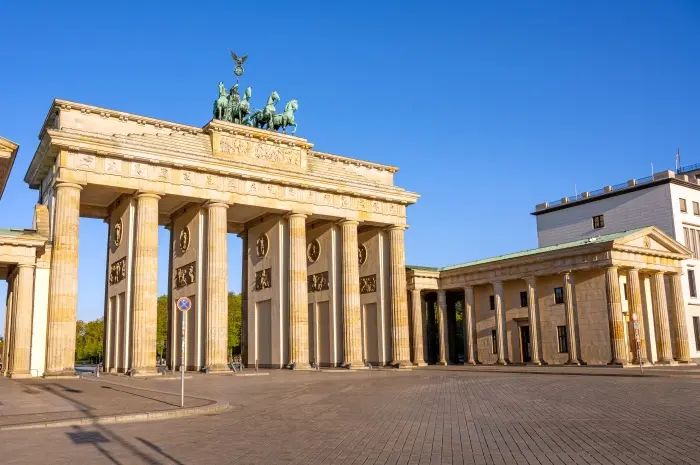Dive into our comprehensive guide to Berlin’s top 10 tourist attractions, showcasing the city’s rich history, vibrant culture, and modern appeal.
Berlin, a city that has witnessed profound historical events and remarkable transformations, stands today as a vibrant hub of culture, art, and politics in Germany.
With its eclectic mix of modernity and remnants from the past, Berlin offers visitors a unique experience.
This article provides an in-depth look at the ten most popular tourist attractions in Berlin, each offering insight into the city’s diverse heritage and dynamic urban landscape.
1. Brandenburg Gate
The Brandenburg Gate is not only Berlin’s most iconic landmark but also a symbol of German unity and peace.
Built in the late 18th century as a city gate, today it stands at the heart of Berlin, having witnessed the city’s tumultuous history, including the dark days of the Cold War when it was inaccessible to both East and West Berliners.
The Gate’s majestic design and historical significance make it a must-visit, drawing tourists from around the globe.
2. The Reichstag Building
Home to the German parliament, the Reichstag is a fascinating blend of historical architecture and modern technology.
The original building was completed in the 1890s, but it was significantly renovated in the 1990s with the addition of a striking glass dome designed by architect Norman Foster.
Visitors can walk up the dome to enjoy panoramic views of the cityscape and learn about German politics and history.
3. Berlin Wall Memorial and East Side Gallery
The Berlin Wall Memorial on Bernauer Strasse and the East Side Gallery along the banks of the River Spree preserve the memories of Berlin’s divided past.
3The Memorial provides a sobering reminder of the physical and metaphorical divide that once split the city, featuring remains of the Wall, an exhibition, and the Chapel of Reconciliation.
The East Side Gallery, on the other hand, is a 1.3-kilometer-long section of the Wall turned into an open-air gallery featuring murals that celebrate freedom and reconciliation.
4. Museum Island
Situated in the Spree River, Museum Island is a UNESCO World Heritage site and a cultural treasure trove.
It consists of five internationally significant museums, including the Pergamon Museum and the Altes Museum, which house vast collections of ancient and classical art.
The island is a testament to Berlin’s commitment to preserving and showcasing its rich cultural heritage.
5. Memorial to the Murdered Jews of Europe
Also known as the Holocaust Memorial, this site covers 19,000 square meters with 2,711 concrete slabs arranged in a grid pattern on a sloping field.
Designed by architect Peter Eisenman, the memorial is a powerful tribute to the Jewish victims of the Holocaust and serves as a place of reflection and remembrance.
6. Potsdamer Platz
Once a bustling hub before WWII and later a desolate no-man’s-land during the Cold War, Potsdamer Platz has been reborn as a striking example of modern urban development.
Today, it is filled with skyscrapers, shopping centers, entertainment venues, and restaurants, making it a popular gathering place for locals and tourists alike.
7. Checkpoint Charlie
Checkpoint Charlie was the most famous crossing point between East and West Berlin during the Cold War. Now marked by a replica of the original guardhouse and soldier portraits, it serves as a reminder of the former border controls.
The nearby museum chronicles escape stories and the Cold War’s history, providing context to the tensions that defined the era.
8. Berlin Cathedral
With its magnificent dome and baroque architecture, Berlin Cathedral (Berliner Dom) is one of the city’s most impressive historic buildings.
Located on Museum Island, it offers visitors a chance to explore its richly decorated interior, crypt, and a museum detailing its history. The climb to the dome’s walkway rewards visitors with stunning views of the surrounding cityscape.
9. Charlottenburg Palace
Charlottenburg Palace, the largest palace in Berlin, offers a glimpse into the life of Prussian royalty. The palace’s opulent baroque and rococo interiors are complemented by its expansive gardens, making it a delightful retreat from the urban hustle. The palace complex also includes a mausoleum, a belvedere, and a pavilion.
10. Tiergarten
Tiergarten, Berlin’s largest and most popular inner-city park, is an oasis of tranquility amidst the city’s bustling environment.
Once a royal hunting ground, it now serves as a beloved recreation area with meticulously landscaped gardens, winding paths, and numerous monuments. It is also home to the Berlin Zoo, one of the oldest and most biodiverse zoos in Germany.
Berlin’s top tourist attractions encapsulate the essence of the city’s dynamic history and vibrant cultural scene.
From historic landmarks like the Brandenburg Gate and the Reichstag to cultural treasures on Museum Island and modern developments like Potsdamer Platz, Berlin offers a rich tapestry of experiences that cater to all interests.
Whether you are a history enthusiast, art lover, or simply seeking to experience the atmosphere of one of Europe’s most intriguing cities, Berlin promises an unforgettable journey through its past and present.
